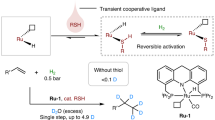Abstract
It has been nearly 70 years since the discovery of Lindlar catalyst and its valuable ability to semi-hydrogenate alkynes to cis olefins. The Lindlar catalyst semi-hydrogenation mechanism appears to still be an ongoing discussion. Spectroscopy (NMR, MS) results are presented regarding the Lindlar catalyst semi-tritiation of terminal alkynes, providing evidence of a novel tritium for hydrogen exchange process taking place.







Similar content being viewed by others
References
Lindlar H (1952) A new catalyst for selective hydrogenations. Helv Chim Acta 35:446–450
Filer CN (2020) Lindlar catalyst: its discovery, magic and mystery. Chem Educ 25:18–24
Ulan JG, Maier WF, Smith DA (1987) Rational design of a heterogeneous Pd catalyst for the selective hydrogenation of alkynes. J Org Chem 52:3132–3142
Ulan JG, Kuo E, Maier WF, Rai RS, Thomas G (1987) Effect of lead acetate in the preparation of the Lindlar catalyst. J Org Chem 52:3126–3132
McEwen AB, Guttieri MJ, Maier WF, Laine RM, Shvo Y (1983) Metallic palladium, the actual catalyst in Lindlar and Rosenmund reductions? J Org Chem 48:4436–4438
Yu J, Spencer JB (1998) Discovery that quinoline and triphenylphosphine alter the electronic properties of hydrogenation catalysts. Chem Commun 10:1103–1104
Yu J, Spencer JB (1997) Regioselective hydrometalation of alkenes reveals the amphipolar nature of the Pd-H bond in heterogeneous hydrogenation. J Org Chem 62:8618–8619
Garcia-Mota M, Gomez-Diaz J, Novell-Leruth G, Vargas-Fuentes C, Bellarosa L, Bridier B, Perez-Ramirez J, Lopez N (2011) A density functional theory study of the “mythic” Lindlar hydrogenation catalyst. Theor Chem Acc 128:663–673
Albers PW, Moebus K, Frost CD, Parker SF (2011) Characterization of beta-palladium hydride formation in the Lindlar catalyst and in carbon-supported palladium. J Phys Chem C 115:24485–24493
Buchi G, Wuest H (1971) Synthetic studies on damascenones. Helv Chim Acta 54:1767–1776
Ghosh AK, Krishnan K (1998) Chemoselective catalytic hydrogenation of alkenes by Lindlar catalyst. Tetrahedron Lett 39:947–948
Shi Y, Peng LF, Kishi Y (1997) Enantioselective total synthesis of fumonisin B2. J Org Chem 62:5666–5667
Righi G, Rossi L (1996) Mild regioselective catalytic hydrogenation of alpha, beta-unsaturated carbonyl compounds with Lindlar catalyst. Synth Commun 26:1321–1327
Ahern DG, Egan JA, Nugent RP, Filer CN (2013) Synthesis of some 6-keto morphinan mu opiate receptor agonists labelled with tritium at high specific activity. J Radioanal Nucl Chem 295:1029–1031
Seki I, Takagi H, Kobayashi S (1964) Pharmacological studies on morphine derivatives. I. Pharmacological actions of several normorphines and 14-hydroxynormorphinones. Yakugaku Zasshi 84:255–267
Silverstein RM, Bassler GC (1967) Spectrometric identification of organic compounds. Wiley, New York, p 118
Williams PG, Morimoto H, Wemmer DE (1988) Application of modern 3H NMR techniques to analysis of complex isotopic products from a hydrogenation reaction. J Am Chem Soc 110:8038–8044
Randall MH, Altman LJ, Lefkowitz RJ (1977) Structure and biological activity of (-)-[3H] dihydroalprenolol, a radioligand for studies of beta-adrenergic receptors. J Med Chem 20:1090–1094
Feoktistov VM, Bunina-Krivorukova LI, Balyan KV (1978) Condensation of aromatic compounds with allylic halides. XXIII. Preparation of p-cresol beta, gamma, gamma-D3-allyl ether and its rearrangement in the presence of Lewis acids. Zh Org Khim 14:807–811
Filer CN, Ahern DG, Fazio R, Seguin RJ (1981) Reduction of the N-propargyl group with tritium. General procedure for the preparation of N-[2, 3-3H] allyl opiate ligands at high specific activity. J Org Chem 46:4968–4970
Woodward RB, Cava MP, Ollis WD, Hunger A, Daeniker HU, Schenker K (1963) The total synthesis of strychnine. Tetrahedron 19:247–288
Perly B, Pappalardo GC, Grassi A (1986) Molecular determinants for drug-receptor interactions. 6. Proton 500 MHz NMR spectra of the narcotic antagonists naloxone and naltrexone by two dimensional 1H–1H chemical shift correlation spectroscopy. Z Naturforsch 41B:231–238
Funke CW, de Graaf JS (1986) A 1H and 13C nuclear magnetic resonance study of three quaternary salts of naloxone and oxymorphone. J Chem Soc Perkin Trans II:735–738
Coe JW, Hawes CR, Towers P (1995) A preparation of high specific activity [11, 12-3H]-9-cis-retinoic acid. J Label Compd Radiopharm 36:587–594
Joly N, Vaillant C, Cohen AM, Martin P, El Essassi M, Massoui M, Banoub J (2007) Structural determination of the novel fragmentation routes of zwitteronic morphine opiate antagonists naloxonazine and naloxone hydrochlorides using electrospray ionization tandem mass spectrometry. Rapid Commun Mass Spectrom 21:1062–1074
Author information
Authors and Affiliations
Corresponding author
Additional information
Publisher's Note
Springer Nature remains neutral with regard to jurisdictional claims in published maps and institutional affiliations.
Rights and permissions
About this article
Cite this article
Filer, C.N. Terminal alkyne semi-tritiation with Lindlar catalyst and its mechanism implications. J Radioanal Nucl Chem 326, 1727–1732 (2020). https://doi.org/10.1007/s10967-020-07468-z
Received:
Accepted:
Published:
Issue Date:
DOI: https://doi.org/10.1007/s10967-020-07468-z



